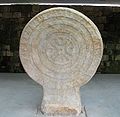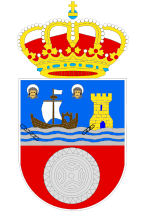
Cantabrian stelae
Encyclopedia


Romanization
In linguistics, romanization or latinization is the representation of a written word or spoken speech with the Roman script, or a system for doing so, where the original word or language uses a different writing system . Methods of romanization include transliteration, for representing written...
of Cantabria
Cantabria
Cantabria is a Spanish historical region and autonomous community with Santander as its capital city. It is bordered on the east by the Basque Autonomous Community , on the south by Castile and León , on the west by the Principality of Asturias, and on the north by the Cantabrian Sea.Cantabria...
in northern Iberian Peninsula
Iberian Peninsula
The Iberian Peninsula , sometimes called Iberia, is located in the extreme southwest of Europe and includes the modern-day sovereign states of Spain, Portugal and Andorra, as well as the British Overseas Territory of Gibraltar...
. Cantabrian stelae include swastika
Swastika
The swastika is an equilateral cross with its arms bent at right angles, in either right-facing form in counter clock motion or its mirrored left-facing form in clock motion. Earliest archaeological evidence of swastika-shaped ornaments dates back to the Indus Valley Civilization of Ancient...
s, triskeles, cross
Cross
A cross is a geometrical figure consisting of two lines or bars perpendicular to each other, dividing one or two of the lines in half. The lines usually run vertically and horizontally; if they run obliquely, the design is technically termed a saltire, although the arms of a saltire need not meet...
es, spiral
Spiral
In mathematics, a spiral is a curve which emanates from a central point, getting progressively farther away as it revolves around the point.-Spiral or helix:...
s, helix
Helix
A helix is a type of smooth space curve, i.e. a curve in three-dimensional space. It has the property that the tangent line at any point makes a constant angle with a fixed line called the axis. Examples of helixes are coil springs and the handrails of spiral staircases. A "filled-in" helix – for...
es, warriors or pre-Roman funerary representations among their usual ornamentation. The most famous is called Estela de Barros (Barros Stele) which can be visited in the Parque de las Estelas (Stelae Park) in the town of Barros, in Los Corrales de Buelna
Los Corrales de Buelna
-Politics:The current mayor of the municipality is Mercedes Toribio Ruiz, from PP. Unlike most other municipalities, Falangist forces were present in the municipal council for many years following the transition to democracy.-Demographic development:...
. This stele is part of the current coat of arms of Cantabria
Coat of arms of Cantabria
The coat of arms of Cantabria has a rectangular shield, round in base and the field is party en fess. In field azure, a tower or crenellated and masoned, port and windows azure, to its right a ship in natural colours that with its bow has broken a chain going from the tower to the dexter flank of...
and the meaning of tetraskele would be related to solar worship. The Barros stele giant size represents the main difference to the smaller stelae found in other parts of northern Spain
Spain
Spain , officially the Kingdom of Spain languages]] under the European Charter for Regional or Minority Languages. In each of these, Spain's official name is as follows:;;;;;;), is a country and member state of the European Union located in southwestern Europe on the Iberian Peninsula...
. In addition to the Estela de Barros, we can see another larger, fragmented stele in the Parque de las Estelas.
Other found stelae are exhibited in the Regional Museum of Prehistory and Archaeology of Cantabria in Santander
Santander, Cantabria
The port city of Santander is the capital of the autonomous community and historical region of Cantabria situated on the north coast of Spain. Located east of Gijón and west of Bilbao, the city has a population of 183,446 .-History:...
. There are two stelae found in Lombera, another found in Zurita
Zurita
Zurita is an Aragonese surname, and may refer to:* Christian Rodrigo Zurita* Humberto Zurita* Jerónimo Zurita y Castro* Leonardo Valdés Zurita* Manuel Fernando Zurita* Maribel Zurita...
, showing the iconographic decoration of a vulture pouncing on a fallen warrior, and another from near the Cantabri
Cantabri
The Cantabri were a pre-Roman Celtic people which lived in the northern Atlantic coastal region of ancient Hispania, from the 4th to late 1st centuries BC.-Origins:...
an castrum of Espina del Gallego. In turn, fragments of other Cantabrian stelae have been found, like the third of Lombera and the Stele of San Vicente de Toranzo, where on one side is depicted a cantabrian warrior on horseback, along with other smaller.
The Cantabrian stelae are the most important testimony of the Cantabri
Cantabri
The Cantabri were a pre-Roman Celtic people which lived in the northern Atlantic coastal region of ancient Hispania, from the 4th to late 1st centuries BC.-Origins:...
pre-Roman people and one of the most representative symbols of Cantabria today, being still used in Cantabria during the Middle Ages
Middle Ages
The Middle Ages is a periodization of European history from the 5th century to the 15th century. The Middle Ages follows the fall of the Western Roman Empire in 476 and precedes the Early Modern Era. It is the middle period of a three-period division of Western history: Classic, Medieval and Modern...
and even during the Baroque
Baroque
The Baroque is a period and the style that used exaggerated motion and clear, easily interpreted detail to produce drama, tension, exuberance, and grandeur in sculpture, painting, literature, dance, and music...
, like the old ones, but losing partly the discoid shape and replacing the solar motives with crosses. The medieval and modern discoid stelae were also typical of other regions of northern Spain. Numerous examples were found in the Basque Country
Basque Country (autonomous community)
The Basque Country is an autonomous community of northern Spain. It includes the Basque provinces of Álava, Biscay and Gipuzkoa, also called Historical Territories....
, and several in Navarra, as well as in Cantabria.
Current impact
A modern interpretation of these stelae and the roman flag, Cantabrum, gives rise to the current Cantabrian lábaru, an unofficial flag but widely used in Cantabria. In the same way, stonemasons and artists from many parts of Cantabria reproduce ancient stelae or create new ones like those, carved in stone or wood, sometimes used as ornaments for new constructions. Similarly stelae reproductions, in wood or metal, are commonly found in pendants and small figures, all of which give an idea of the importance as a Cantabrian symbol.Cantabrian stelae of Roman and pre-Roman times
Although the ancient CantabriCantabri
The Cantabri were a pre-Roman Celtic people which lived in the northern Atlantic coastal region of ancient Hispania, from the 4th to late 1st centuries BC.-Origins:...
people produced many stelae, the best known are the giant stelae, of which five are known, four of them having been discovered in the valley of Buelna. They are usually dated from the 1st century B.C. to 1st century A.D., although there are differences between them, and some could even be 5th or 6th century B.C.
| Name | Diameter (cm) | Period | Place of discovery |
|---|---|---|---|
| Estela de Barros 1 | |
3rd century AD | Barros |
| Estela de Barros 2 | |
Barros | |
| Estela de Lombera 1 | |
Los Corrales de Buelna Los Corrales de Buelna -Politics:The current mayor of the municipality is Mercedes Toribio Ruiz, from PP. Unlike most other municipalities, Falangist forces were present in the municipal council for many years following the transition to democracy.-Demographic development:... |
|
| Estela de Lombera 2 | |
Los Corrales de Buelna Los Corrales de Buelna -Politics:The current mayor of the municipality is Mercedes Toribio Ruiz, from PP. Unlike most other municipalities, Falangist forces were present in the municipal council for many years following the transition to democracy.-Demographic development:... |
|
| Estela de Zurita | |
1st century BC - 1st century AD | Zurita |
| Name | Diameter (cm) | Period | Place of discovery |
|---|---|---|---|
| Estela de Lombera 3 | |
Los Corrales de Buelna Los Corrales de Buelna -Politics:The current mayor of the municipality is Mercedes Toribio Ruiz, from PP. Unlike most other municipalities, Falangist forces were present in the municipal council for many years following the transition to democracy.-Demographic development:... |
|
| Estela de Luriezo | |
1st century AD | Luriezo |
| Estela de Toranzo | Espina del Gallego |

